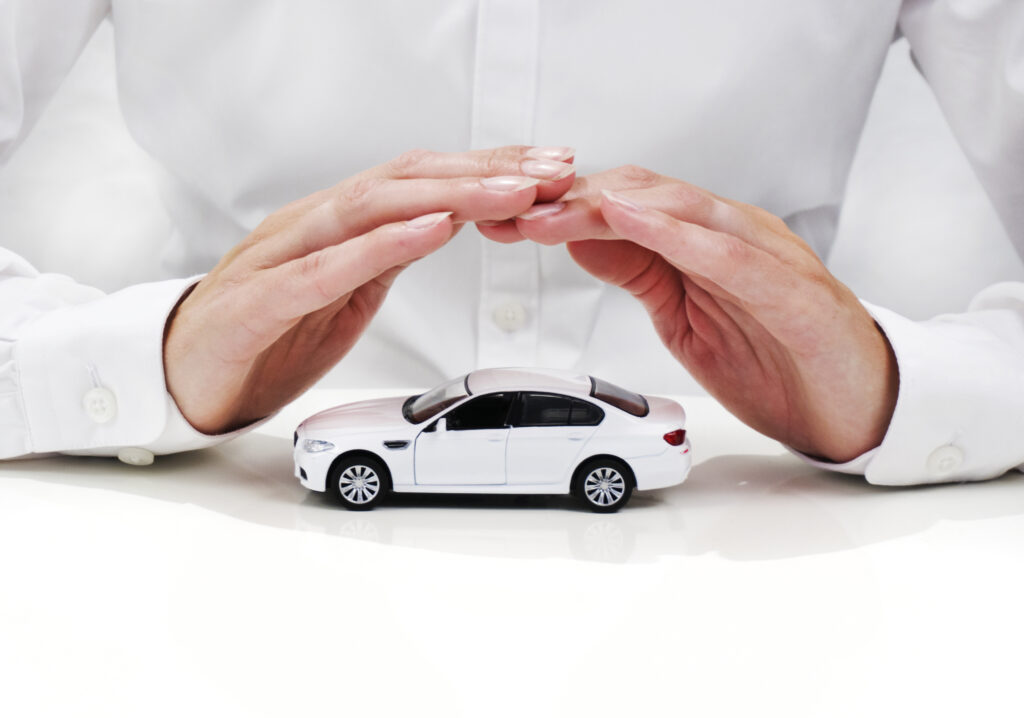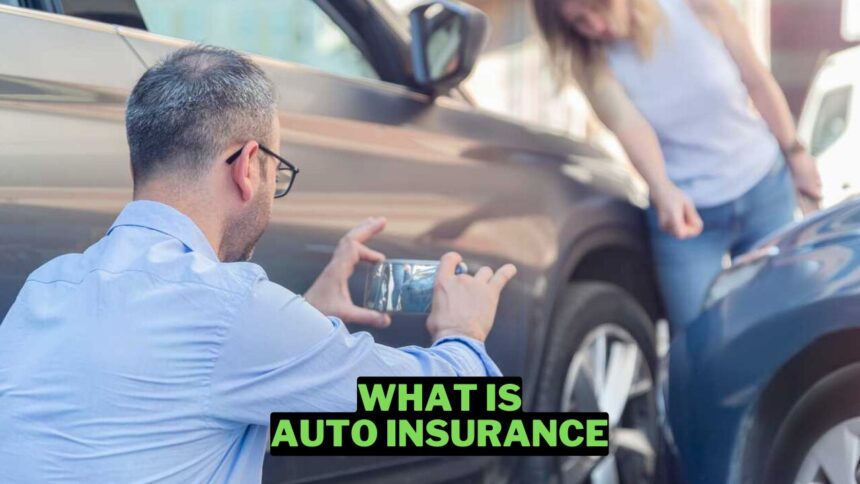When purchasing or renting a vehicle, it is crucial to safeguard your investment. Auto insurance provides peace of mind by providing coverage in the event of an accident, theft, vandalism, or natural disaster-related damage.
Instead of bearing the financial burden of car accidents, individuals pay annual premiums to an auto insurance company, which subsequently covers a significant portion or all of the expenses incurred from such incidents or vehicle harm.
Read More:
- What is Errors & Omissions (E&O) Insurance
- What is General Liability Insurance
- What is Restaurant Insurance
What Is Car Insurance?

Auto insurance is a form of property and casualty insurance designed to assist with the cost of repairing your vehicle following a covered loss, such as a car accident. This insurance provides financial security in situations where your car is damaged in a non-collision event, like hail or a falling tree, as well as in cases of theft.
By paying a premium, which is the amount you contribute towards your policy, the insurance company will cover the expenses within the limits of your policy. Auto insurance operates by providing indemnity, which means it guarantees that the policyholder will be fully compensated or restored to their initial financial state.
If your vehicle sustains damage or you are legally challenged due to an accident that you caused, your insurance policy can assist in covering the costs of repairs, replacements, medical expenses, and any other liabilities for which you are held responsible.
Auto insurance policies are determined by coverage limits, which represent the maximum payout an insurance company will provide for a claim. In addition, certain coverage options may have deductibles, which require policyholders to pay a specific amount before the insurance company covers the rest of the expenses.
There are various types of car insurance available, allowing individuals to personalize their policies and obtain the specific coverage they require.
How Auto Insurance Works
When you purchase auto insurance, you agree to pay a premium to the insurance company. In return, the insurance company promises to cover any losses that are specified in your policy. The cost of the policy is determined based on your specific requirements and financial constraints, allowing you to customize your coverage amounts.
Typically, policy terms last for six or twelve months and can be renewed. The insurance company will send you a notification when it’s time to renew your policy and make another premium payment.
Almost all states, whether or not they make it compulsory to have a minimum level of auto insurance, demand that vehicle owners possess bodily injury liability coverage. This coverage takes care of expenses linked to injuries or fatalities caused by you or another driver while driving your car.
Additionally, some states may also necessitate property damage liability coverage, which compensates others for any damage caused by you or another driver operating your car to another vehicle or property.
In several states, there are additional requirements for car owners regarding auto insurance. These requirements include having medical payments or personal injury protection (PIP) coverage. This type of coverage helps in reimbursing medical expenses for injuries sustained by the policyholder or their passengers. Additionally, it provides coverage for lost wages and other relevant expenses.
If you get into an accident and the other driver doesn’t have auto insurance, uninsured motorist coverage will provide compensation for the damages. On the other hand, underinsured motorist coverage is meant to safeguard you in case of an accident with a driver who has insurance, but the coverage is insufficient to cover the entire claim amount.
Auto Insurance Costs
There are two primary costs associated with purchasing car insurance: premiums and deductibles.
The cost of auto insurance can differ based on various factors that are taken into consideration during the evaluation process. These factors may include the gender of the applicant, their age when applying for insurance, the number of years they have been driving, their history of accidents and moving violations, and other relevant factors.
It is important to note that most states require a minimum level of auto insurance coverage. The specific minimum requirement varies from state to state, but many individuals choose to purchase additional insurance to provide themselves with further protection.
In addition, when you’re financing a car, the lender might require specific types of auto insurance. For example, if you’re buying a costly vehicle that will probably lose value rapidly after you take it from the dealership, you may need gap insurance.
This type of insurance can assist in covering the gap between the actual value of the vehicle and the remaining amount you owe on it in case of an accident. Having a history of bad driving or wanting extensive coverage will result in higher costs for auto insurance.
However, you have the option to lower your premiums by opting for more risk and raising your deductible. Auto insurance deductibles are the out-of-pocket expenses that policyholders are responsible for paying before their insurance company covers any damages.
This means that if you file a claim, you will need to pay a certain amount upfront, such as $500 or $1000, depending on your policy’s deductible. Opting for a higher deductible can lead to reduced insurance premiums. However, it is important to assess your ability to afford the higher deductible amount in case you need to file a claim.
Who Does Auto Insurance Coverage Protect?
Auto insurance is designed to offer protection not only to you but also to your family members who are listed on the policy. This coverage extends to situations where you or your family members are driving your vehicle or someone else’s vehicle with their permission.
Additionally, your auto insurance policy also provides coverage to individuals who are not listed on your policy but are driving your car with your consent.
Auto insurance is designed to provide coverage for personal driving situations. However, it does not offer protection if you use your vehicle for commercial purposes like making deliveries.
Additionally, it does not cover you if you use your car to work for ride-sharing services such as Uber or Lyft. Nevertheless, some auto insurance companies now offer optional supplemental insurance products, which come at an additional cost, to extend coverage for vehicle owners who provide ride-sharing services.
Do I Need Car Insurance?
If you operate or possess an automobile, you will probably require auto insurance. Almost all states have made it obligatory to have some form of auto insurance, although the specific legal requirements and minimum coverage limits may differ from state to state.
If you are responsible for causing an accident and harming another driver or their passengers, or damaging someone’s property like a fence or mailbox, most auto insurance policies require coverage for third-party bodily injury and property damage liability claims.
In addition, you may be required to have medical coverage for yourself and your passengers, which can come in the form of personal injury protection (PIP) or medical payments (MedPay) coverage.
Auto insurance policies often offer optional physical damage coverages, like comprehensive and collision coverage. However, these coverages may become mandatory if you decide to finance or lease your car.
By having these coverages, you receive protection for your vehicle in case of damage, and you are responsible for covering the costs of repairs or replacement.
How Much Car Insurance Do I Need?
When figuring out the appropriate amount of auto insurance you should have, it is important to first check the mandatory insurance requirements in your state.
Liability insurance is typically required by most states, but there may be additional types of coverage mandated, such as uninsured motorist coverage or personal injury protection (PIP).
If you have financed or leased your vehicle, it is advisable to consult with your lender or lessor to find out the specific type and level of coverage that is necessary as per your loan or lease agreement.
It is important to note that these suggestions serve as a starting point, as individual insurance coverage requirements may differ.
If you believe that you may not have the financial capacity to handle legal, medical, or repair costs following an accident, or if you possess valuable assets that you wish to safeguard, it is advisable to contemplate acquiring an auto insurance policy with higher coverage limits.
What auto insurance covers
Here are some of the most common types of car insurance coverage and what they cover:
- Uninsured motorist coverage
- If you get into an accident with a driver who doesn’t have auto insurance, uninsured motorist coverage will cover the expenses for your medical treatment and the repair of your property.
- Underinsured motorist coverage
- Underinsured motorist coverage for underinsured motorists functions similarly to coverage for uninsured motorists. This type of coverage comes into play when the expenses incurred from your own medical bills and property damage surpass the liability coverage limits of the at-fault driver.
- Collision coverage
- Collision coverage is a type of policy that covers the costs of repairing your own vehicle after a traffic-related accident, regardless of who is responsible for the collision.
- Gap insurance
- Gap insurance is a type of coverage that helps cover the gap between the amount you owe on your car loan or lease and the actual market value of your vehicle if your car is declared a total loss.
- Personal injury protection coverage
- Auto insurance policyholders can benefit from personal injury protection coverage, commonly referred to as PIP. This coverage ensures that medical expenses are covered regardless of who is deemed responsible for the accident. Furthermore, PIP may also extend its coverage to expenses such as funeral costs or child care.
- Medical payments coverage
- Auto insurance medical payments coverage provides financial assistance for medical expenses incurred by you and your passengers following an accident, regardless of who is responsible for the collision.
- Comprehensive coverage
- Auto insurance provides comprehensive coverage that acts as a form of protection against various unpredictable events. This type of coverage ensures that repair expenses resulting from severe weather conditions such as tornadoes or hurricanes, acts of vandalism, or collisions with wild animals are covered.
What auto insurance won’t cover
Auto insurance is not a mystical shield that safeguards your vehicle from all possible risks. Just like how health insurance usually does not cover every medical cost, auto insurance also does not provide coverage for every expense related to your car.
Here are a few examples of things car insurance won’t cover.
- Stolen belongings
- In the unfortunate event that someone breaks your car window and steals your laptop, your auto insurance is unlikely to cover the cost of replacing it. However, if you have a homeowners or renters insurance policy, it can provide coverage for items stolen from your car, as long as it falls within the limits specified in your policy.
- Wear and tear
- Typically, auto insurance policies do not provide coverage for expenses such as oil changes or flat tire repairs. Unless the damage is a result of an accident, it is unlikely that your insurance will cover these costs.
- Rideshare trips
- When you drive for a rideshare service such as Uber or Lyft, your auto insurance will not provide coverage. These companies have their insurance that only applies once you have accepted a fare and are transporting a passenger, but not during the time between rides.
- However, some insurance providers offer optional rideshare insurance as an addition to your policy, which can provide coverage during the times when you are not covered by the rideshare company’s insurance.
- The cost of a new car
- If you do not have new car replacement coverage, your comprehensive and collision insurance may not provide enough compensation to replace your vehicle following an accident.
- If your car is deemed a total loss and you have these types of coverage on your policy, your insurance provider will assess the value of your vehicle at the time of the accident to determine the amount you will be paid.
- Auto insurance can often be a source of frustration due to the fact that many coverage options are not mandatory and vary depending on the insurance provider. Therefore, when searching for car insurance, it is crucial to prioritize the additional coverage types you desire in your policy.






This article provides a helpful overview of the different types of auto insurance coverage and their importance. It’s important to assess your ability to afford a higher deductible amount in case of a claim. Additionally, it’s worth considering optional supplemental insurance products if you use your car for ride-sharing services.
This article provides helpful information about what auto insurance won’t cover. It’s important to know the limitations of your policy and consider additional coverage options.
Auto insurance is essential for protecting your investment in a vehicle. It provides coverage for accidents, theft, and damage caused by natural disasters. It’s important to understand the different types of coverage and costs associated with auto insurance to make informed decisions.
This article provides helpful information about the different types of auto insurance coverage and the importance of assessing your needs and financial ability. It’s important to understand the mandatory requirements in your state and consider additional coverage options based on your situation.
This article provides a helpful reminder of what auto insurance won’t cover. It’s important to understand the limitations of your policy and consider additional coverage options that may be necessary for your specific needs.